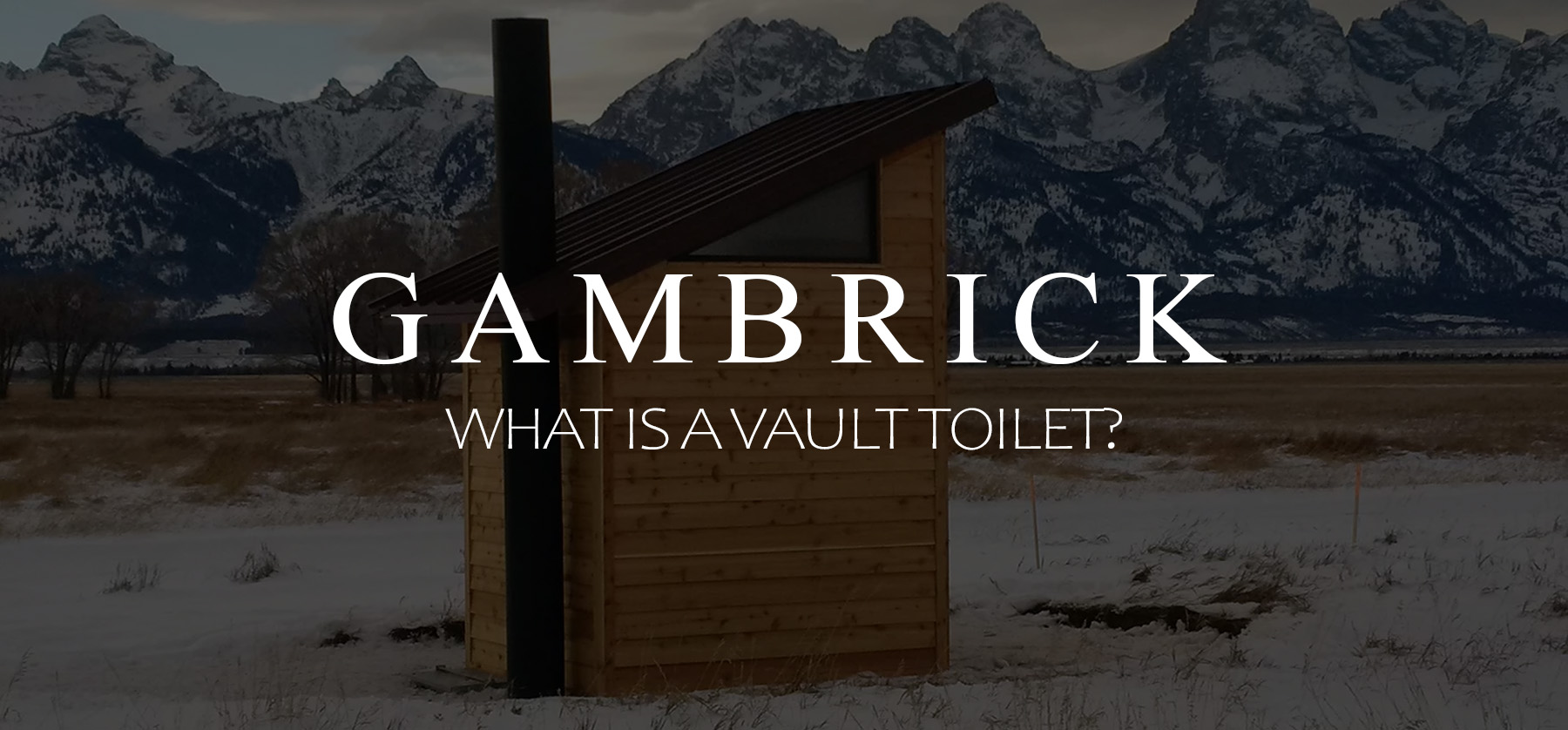What Is A Vault Toilet?
A vault toilet is a permanent Waterless Bathroom that sits above a vault or “pit” that is serviced by a waste management company. Vault restrooms do not require plumbing or electricity but need vehicle access to service them. Because vault toilets are waterless, they’re non-flush and store waste in a large airtight underground container, a.k.a. the vault. Hence the name, vault toilet. Vacuum pumping trucks pump out the vault and transport it’s waste to a management facility. Vault toilets are generally built in areas where water isn’t readily available like parks and campgrounds.
Vault toilets are also called camping toilets because they commonly built on campgrounds. Pit toilets, composting toilets, port-a-potties, and bag toilets are other forms of waterless toilets. They typically made as single or double vault systems and feature unisex toilets. They can be made from wooden frames, reinforced concrete, plastic, or cross-linked polyethylene. This is because the material will not crack, so there’s less risk of pollution. Plastic vaults are a good choice because they’re portable, but not as strong as other materials.
Concrete vault toilets are highly durable but the cross-linked polyethylene type are the most widely used.
The main advantages of a vault toilet is that they don’t require plumbing. In hard to get to rural areas, they’re typically the only option for a bathroom. They also reduce water usage and environmental pollution because they consume no energy to use. Although they do require a vacuum truck to remove the waste.
Most public vault toilets meet ADA regulations for toilets and user comfort. They’re generally odorless when properly maintained although that’s not always the case. The U.S Forest service nick-named vault toilets as a “sweet-smelling toilet” because of there overall lack of smell.
How Does A Vault Toilet Work?
Vault toilets don’t have any plumbing or a water supply. The toilets are non-flush and attach to a holding vault that fills with waste. This container, or tank, can store over ten thousand gallons of waste. Vault toilets are basically the same as a port-a-john. When the storage tank fills, a vacuum truck comes and pumps it out. This is why vehicle access is so essential.
The waste storage container, a.k.a. vault, is buried underground with a concrete slab poured on top to keep it stable. The vault is generally positioned along a slope so waste can flow easily. A structure that connects to a vent pipe is built on top of the concrete slab. This structure is essentially the bathroom area.
Waste held inside the vault remains there until it’s pumped out by a waste management company. Vaults don’t have to be pumped frequently if the right size is installed for its use. Generally, a vault toilet is pumped every week or two.
Vault toilets are generally odorless, but this isn’t always the case. For it to be odorless, air must carry away the smell. If there’s no wind, the smell can build. Winds carry the smell away from the toilet. Wind creates pressure. When air flows into a building, it increases the air pressure which forces air to flow out. This releases the vault of odor.
The sun also helps control odors. When the vent is heated, the smell is forced out of the pipe and up so you won’t smell it. If there’s no sun, stagnant air stays in the pipe and you may smell it.
Where Are Vault Toilets Used?
Vault toilets are commonly built in public parks and campgrounds where water and plumbing are not available. They’re generally designed to fit in with the natural environment and look similar to a small cabin.
They’re permanent structures without water or electricity but feature a large vent pipe extending from the roof. This is one of their defining features.
In most out of the way rural areas, a vault toilet is the only way to build a permanent bathroom facility.
Vault Toilet Pros
There are a lot of benefits to building a vault toilet. The biggest being location.There aren’t a lot of bathrooms in out of the way rural areas like camp grounds. A vault toilet is a functioning toilet in the middle of nowhere with 4 walls, a roof and a locking door. That’s a much better option for some than going in the woods.
Here are a few more pros:
- Bathroom: Vault toilets are built inside of an enclosed bathroom with a door. That’s a huge plus when you’re on a rural campsite.
- Privacy: Vault toilets are a small self-contained bathroom with a door, which means one person uses it at a time ensuring privacy.
- Easy Maintenance: Vault toilets are easier to maintain than traditional toilet systems because they have no plumbing.
- Affordable: They’re cheaper to build than a regular bathroom because there’s no plumbing or water supply. Although there’s the long term expense of pumping to consider.
- Convenience: Vault toilets are available on demand in rural recreational areas. You won’t have to go back to your house or into the woods to use the toilet.
- Portable: Vault toilets made from plastic are moveable so you can be use them in different locations.
- Special Features: Some vault toilets have battery-powered lights which makes them easier to use in the dark. They also provide optional dispensers for disinfecting the toilet after use.
- Cost Effective: Vault toilets don’t require water so there’s no need to flush. This saves on water bills and keeps build costs down.
- Smell: Vault toilets are designed not to smell. Although sometimes they still do.
Vault Toilet Cons
Despite all the benefits of building a vault toilet, they’re not perfect and do have a few drawbacks. One of the biggest being a lack of running water. Sure, not using water is also a benefit because you can build a bathroom almost anywhere, but it’s still nice to have an actual flushing toilet and a sink to wash your hands when you’re done.
- Heat: In order for the vent pipe to carry out odor, it needs heat from the sun. On cloudy days vault toilets can start to smell. They’re also not heated which is an issue in winter.
- Waste: Garbage can cause blockages in the vault. It’s very important not to put anything in the toilet that doesn’t belong.
- Ventilation: If the vault ventilation system isn’t working properly the bathroom can start to smell.
- Movement: Plastic vault toilets are the only design that can move. And even they aren’t easy to move around. If you’re looking for a temporary bathroom that can be moved, you’re probably better off with a port-a-john.
- Sanitation: Since vault toilets are waterless, they need regular cleanings.
Ways to Reduce Vault Toilet Odors
The sun and wind are the main ways vault toilets reduce odors. They work together to move odors up the wipe and away from the bathroom. However, when wind and sun are unavailable, foul odor can still be reduced.
Here are a few things you can try:
- Add organic filler to the vault which converts Hydrogen Sulfide and Ammonia (the bad odor in the waste) to odorless nitrogen gas.
- Place a burning flame around the vent to incinerate the smell as it leaves the vent.
- Try activated carbon to deodorize the gas.
- Use a long underground pipe to transport odor far away from the toilet.
- Use solar power, a generator or fuel to power fans that move odors away from the bathroom.
How To Care For A Vault Toilet
Vault toilets are prone to bacteria and other disease causing organisms. They need regular cleanings inside the bathroom area and the vault needs to be pumped.
- Make sure the vault is pumped out on a regular schedule.
- Disinfect the bathroom area when the vault toilet is in use.
You’ll also need to care for the building itself. Vault toilets have 4 walls and a roof like a small cabin. Keep the roof in good shape to prevent leaks.
Check the concrete slab for cracks. If you find a crack starting to develop, fill it and seal the concrete immediately. Cracks can spread down into the vault.
Check the walls of the building for rot or weather damage. Especially around doors and windows and the base of the structure. If you’ve built the bathroom area with wood, this is where rot will appear.
Make sure the site always has vehicle access. A vacuum truck needs to access the bathroom in order to pump it out.
Check working parts of the bathroom like door knobs and locks if you use them. Small parts are always what seems to break first in public restrooms.
Tips For Using A Vault Toilet
Vault toilets are public restrooms far away from most civilization, so you never know what you’re gonna find in there. And they’re lacking basic amenities found in most bathrooms, like sinks and running water.
- Check For Insects: be careful when opening the door of a vault toilet. There could be flies, bees, spiders or other insects nesting inside.
- Bring Your Own Toilet paper: Park personnel generally keep the vault toilet stocked with toilet paper, but they do run out. I’d play it safe and assume the toilet is empty. Not to mention they won’t be stocking anything but rough one ply.
- Don’t Throw Trash in the Vault Toilet: Vault toilets are designed only for waste and toilet paper. Don’t throw anything else down the toilet or you could clog it up. Vault toilets are not a big trash can.
- Bring Hand Sanitizer: Vault toilets don’t have a water supply or sink, so bring some hand sanitizer or water of your own if you want to wash your hands when done.
- Belongings: You can bring belongings in the vault toilet with you, but there’s usually no where to put any of it but the floor. I always keep my stuff outside. A public toilet floor isn’t a place I want to lay my backpack.
Some vault toilets include locking doors and some don’t. There’s not really a good solution for this other than bringing a friend to stand by the door.
Is A Vault Toilet The Same As A Pit Latrine?
Vault toilets and pit latrines share the same basic design and are often confused for one another. They’re both commonly found at campgrounds and remote residential areas because they don’t require water to flush. But they’re different in a few important ways.
Pit latrines, a.k.a. pit toilets, involve digging a trench beneath the ground that collects waste. Essentially all they are is a deep hole in the ground similar to a well. The user sits on top of the hole and uses it as a toilet.
Unlike vault toilets that collect waste in a tank that can be pumped clean, pit latrines accumulate waste directly in the soil.
- They’re easier to build because they don’t require a tank, concrete or vent pipe.
- Require little upkeep because you don’t pump them out.
- They’re cheaper to build then a vault toilet.
Pit latrines are not as sanitary as a vault toilet because they’re not cleaned or pumped out. Deep pits are hard to fill up, but when they do, simply fill the top with dirt and dig a new hole. The waste you leave behind is biodegradable and breaks down into fertilizer.
Waste accumulation and the lack of a ventilation system will attract flies and other insects to the pit. This makes the user susceptible to germs and disease.
Vault toilets are modern versions of a pit latrine which can be kept clean and sanitary. They’re superior to a pit toilet in pretty much every way. If you have a choice, you should choose a vault toilet. However, if you’re stuck somewhere extremely remote and have no other options, building a pit latrine is an option. Once the pit is dug you can cover it with some simple walls and a roof to keep dry. They’re basically an old fashioned outhouse.
Is A Vault Toilet The Same As An Outhouse?
A vault toilet is not the same as an old fashioned outhouse. Although they are very similar.
Outhouses function more like a pit latrine, because they don’t have a sunken tank beneath the floor that collects waste and gets pumped out.An outhouse is a small room with a seat positioned over a deep pit. When the pit fills up with waste, it’s covered with dirt and the house is moved over a new hole. Outhouses are not permanent structures, don’t have a vault, a vent, and can not be pumped out.
Vault toilets are a modern, more sanitary form of an outhouse. They’re strong, generally permanent, and can be pumped out. They also usually include a strong concrete floor and ventilation.
Because vault toilets include a ventilation pipe, they smell much better than an outhouse. In an outhouse or pit latrine, there’s nowhere for the smell to go but up and into the bathroom.
Vault toilets are usually built to ADA standards because they’re generally found in parks and other public recreational areas. This is something you’ll find in an outhouse or pit latrine.
How Much Does It Cost To Install A Vault Toilet?
The cost to install a vault toilet depends a lot on the size and design of the room. For a basic one room toilet with a 5,000 gallon vault, concrete slab floor and good quality vent pipe, your looking at around $7,000 – $10,000 for materials. Labor can easily double or triple that number depending on the location. Remember, vault toilets are built in out of the way places. You have to transport the concrete and materials to the site. There may also be excavation needed and you’ll need a fresh water supply to mix the concrete.
$25,000 – $45,000 is a good price range for an all in vault toilet. But that price could go much higher if your building one really far away from civilization.
Remember, vault toilets need pumping so don’t build them too far out of the way. And don;t forget about the maintenance cost to pump the toilet. Here in NJ it’s about $45 per week for a pump and toilet paper refill.
How Deep Is A Vault Toilet?
A vault toilet generally has a 3-foot-deep concrete vault buried beneath the floor. This is accessible from the outside which is why vehicle access is so important. If you can’t pump out the vault, the toilet eventually becomes useless.
In some cases the vault is secured to concrete footings which keep it securely in place.
The average vault toilet floor slab is 4 inches. The vault is another 36 inches on average and rests just under the floor. The vault may sit on 12 inch deep footings depending on its size and design. Some vault don’t require additional footings. In general, the average vault toilet is approximately 40 inches deep which includes the vault and floor slab.
An 18-inch-diameter pipe comes out of the vault and extends up above the bathroom roof to vent out foul odors.
Do Vault Toilets Smell?
I think it’s safe to say that all toilets smell sometimes. But vault toilets are designed to carry away foul odors.
Vault toilets are designed to be odorless, but this isn’t always the case. They feature an 18 diameter pipe that starts at the vault and extends over the top of the bathrooms roof. For the vent system to work properly, wind is needed to create pressure that moves smells through the pipe and carry the stench up and away from the toilet.
Heat is also needed. As the pipe heats up from sunlight, it helps carry odors up and out of the vault.
If there’s no wind and no heat, the stench can cloud around the toilet.
Also these design features don’t do much to reduce smell when someones just been in there. They’re more of a long term odor reducer. For recent odors use Lysol.
Vault Toilet Odor Control
There are a few products you can add to the vault to help control odor. But in general most products don’t work and can make the smell worse. This is because a vault toilet doesn’t have water.
A waterless vault-toilet system, which receives only pure waste, is very concentrated and can have biochemical oxygen demand 50-times higher than a septic or sewer system. This means some products, which are designed for septic or sewer systems that have water, can actually make the smell worse when they interact with the concentrated waste.
Products
- BioWorld’s Liquid Optimizer Plus: Liquid Optimizer Plus is applied with a wand and pressure sprayer to mist the vault walls and surface of the vault’s contents. It reduces odor and
almost eliminates flies when added to the vault weekly. Odor and flies return to pre-treatment levels when treatment stops. - No Stink’s Special Powder: Special Powder is a granular product spread across the surface of the vault’s content. It minimizes odor for 2 or 3 days after treatment. Odor and flies return to pre-treatment levels when treatment stops.
- Armor Research’s Blanket 510:Blanket 510 is poured through the manhole or vault riser after the vault is pumped and surcharged with water. The product is lighter than water and floats on the surface. It can be sprayed onto the vault walls for additional odor reduction. It minimizes both odors and flies and is added only when the vault is pumped and recharged with water.
| Manufacturer | Product | Form | Treatment | Type | Frequency | Cost (2006) |
| BioWorld | Liquid Optimizer Plus | Liquid | One Quart | Biological | Once A Week | $63 per gallon |
| Armor Research | Blanket 510 | Liquid | Enough to make a 1/4″ thick blanket (6.5 square feet per gallon) | Solvent Based | Once when vault is pumped | $10.59 per gallon |
| No Stink | Special Powder | Granular | One Quart |
Mineral | Once or twice a week as needed | $75 per 5 gallon bucket |
Vault Toilet Cleaning
Cleaning a vault toilet is pretty much the same as any other public or private restroom. Disinfect surfaces and handles with spray or wipes, sweep the floors and Lysol the air.
- Disinfect the entire toilet, especially the seat.
- If the walls are covered with F.R.P or Fiber Reinforced Plastic Sheeting, disinfect those too. If the walls are wood you can’t really disinfect it, but you can wipe away dirt or debris.
- Disinfect the entire floor, especially right around the toilet but get the whole floor.
- Sweep the floors of dirt and/or debris.
- If there’s a trash can, empty it out and sanitize the can and lid.
- Clean all the door knobs and grab bars with disinfectant. Anyplace people are prone to touch should be wiped down.
- I recommend bringing some Lysol spray.
Conclusion
Vault toilets are a modern, more sanitary form of the old fashioned outhouse. They’re generally built to be a strong, permanent structure similar to a small cabin with a solid concrete floor. Below the bathroom area is a vault that stores waste which can be pumped out as needed. The vault includes a vent pipe which carries away foul odors. They make bathroom use more civilized in even the most remote areas and most are even built ADA compliant. But they don’t use water. So don’t expect to flush the toilet or wash your hands when you’re done.
Vault toilets are only for waste and toilet paper, not trash. Never put anything into the toilet other than those two things.
If you’re in a remote camping or hiking area and you see small cabin with a big pipe sticking out the top, it may be a vault toilet.
Summary: What Is A Vault Toilet?
A vault toilet is a permanent Waterless Bathroom that sits above a vault or “pit” that is serviced by a waste management company. Vault restrooms do not require plumbing or electricity but need vehicle access to service them. Because vault toilets are waterless, they’re non-flush and store waste in a large airtight underground container, a.k.a. the vault. Hence the name, vault toilet. Vacuum pumping trucks pump out the vault and transport it’s waste to a management facility. Vault toilets are generally built in areas where water isn’t readily available like parks and campgrounds.
Vault toilets are also called camping toilets because they commonly built on campgrounds. Pit toilets, composting toilets, port-a-potties, and bag toilets are other forms of waterless toilets. They typically made as single or double vault systems and feature unisex toilets. They can be made from wooden frames, reinforced concrete, plastic, or cross-linked polyethylene. This is because the material will not crack, so there’s less risk of pollution. Plastic vaults are a good choice because they’re portable, but not as strong as other materials.
Concrete vault toilets are highly durable but the cross-linked polyethylene type are the most widely used.
The main advantages of a vault toilet is that they don’t require plumbing. In hard to get to rural areas, they’re typically the only option for a bathroom. They also reduce water usage and environmental pollution because they consume no energy to use. Although they do require a vacuum truck to remove the waste.
Most public vault toilets meet ADA regulations for toilets and user comfort. They’re generally odorless when properly maintained although that’s not always the case. The U.S Forest service nick-named vault toilets as a “sweet-smelling toilet” because of there overall lack of smell.
If you have any questions about vault toilets, Email any time.





















